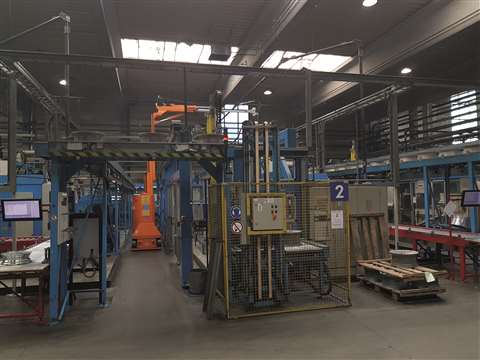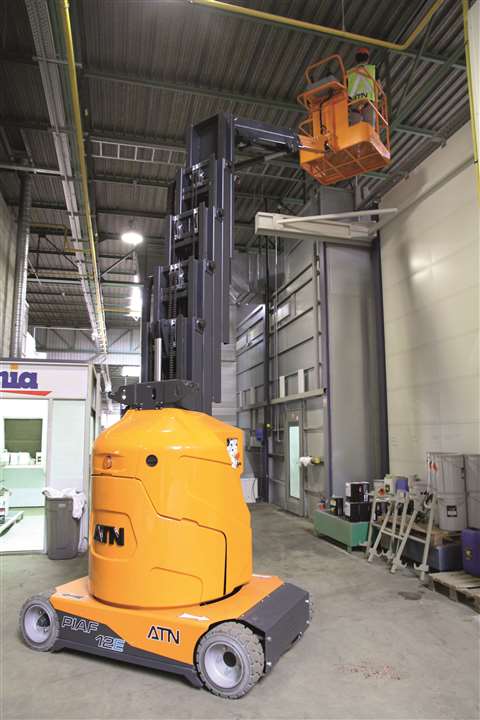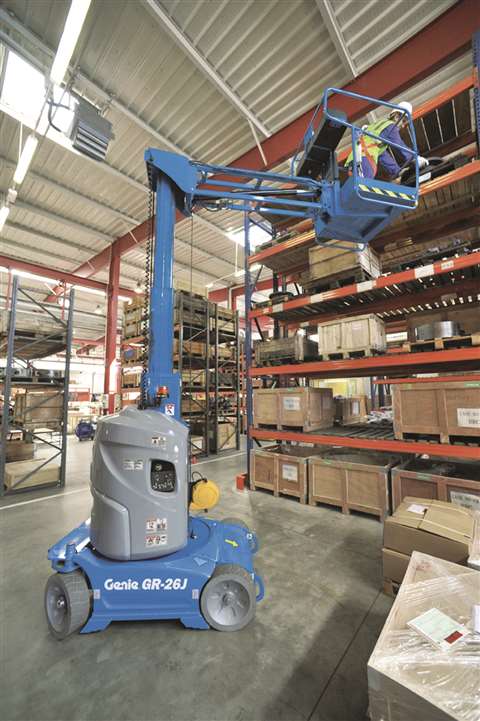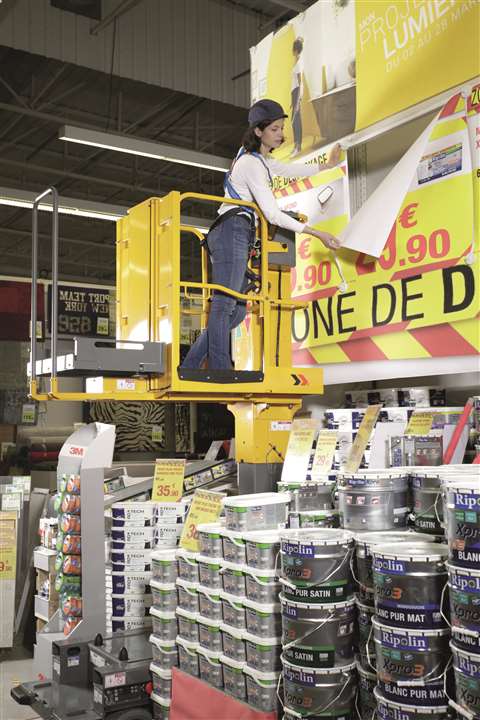VERTICAL MASTS: More and less
08 March 2017

Hematec demonstrates the compact working environment of many vertical mast applications.
Michael Schapperth, sales manager with Germany-based Hematec sums up the requirements of the mast lift market.
“Manufacturers like us are always developing machines according to customers’ needs, to be successful in the market. In this special sector, this always means more compact, more power for working time, more working height, more outreach, more basket capacity, less weight and much more.”
Mr Schapperth adds, “It’s due to the fact, that especially inside production halls of all kinds of industries - the manufacturing industry, food industry, etc. - space is valuable.”

Access for forklifts and workers are getting more and more narrow and also spaces between machinery is getting smaller, he adds.
Hematec’s current models are the Helix 1205, HELIX 1508 and the crane K12500.

The 1205 model has 12m working height, 5m outreach at 200kg basket capacity, while the 1508 has 15 m height and 8 m outreach with 200 kg in the basket. The crane has 12m maximum height with a 500kg hook capacity.
Compact dimension are provided by the narrow undercarriage: the Helix1205 is less than 1 m wide, and the counterweight remains within the chassis. The model has a telescopic jib with two chains, meaning you can work in the negative. The steering angle is 85°, allowing the machine to almost turn on the spot. There is also a long life battery up to 8 hours.
For the future, the company is planning new models with improved parameters, including height and outreach. An example of this type of thinking comes in the K12500 crane, based on the Helix aerial work platform. It’s designed for lifting in very narrow spaces.

The company’s biggest market is Germany and surrounding nations. “Our customers are more and more rental companies, in addition to the current customers like industrial plants,” says Mr Schapperth. This is partly because it’s difficult for maintenance managers to get the required financial resources to buy new.
Rental focus
France-based ATN is always on the innovation trail, mainly in a bid to find solutions required by rental companies.
Daniel Duclos, president of ATN, says there is a trend for electric drive, improved gradeability and transportability, as well as clean energy and noise reduction. And echoing previous comments, greater working height and outreach.
ATN’s latest vertical mast model is the PIAF 12E in. Features include a 11.83m working height and and 5.10 m outreach. It’s a fully electric machine with LCD onboard diagnostic console with easy access to the basket and no tail swing.
The manufacturer is working on the PIAF 10E for the end of 2017, a fully electric 10m machine, and like the P12E, it has onboard LCD console, access with gate and no tailswing.
Mr Duclos adds, “All applications are developing everywhere for vertical masts, because it is the access equipment type that has the better chance to reach any place at height in a building.”
Genie offers a complete line of vertical masts in the Genie Runabout family, including the Genie GR, GRC, QS and GRJ. The GR-20J and GR-26J units are the most recent additions with the Genie GR-26J model being the latest to launch in North America. Again, it is all about accessibility -the Genie GR, GRC and QS products all have a zero degree turning radius and compact base size, making them suitable for tight and narrow areas, including many elevators. The proportional controls make these machines easy to manoeuvre and accurately position for work in finished spaces. The narrow size, outreach and rotation mean these units can easily get to spaces above production lines, shelving and equipment without bringing in a full-size boom.
In addition, upcoming changes to the ANSI standard in North America will drive changes across all vertical mast manufacturers, says Zachary Gilmor, Genie associate product manager, Terex AWP. “The changes go beyond just the functionality and classification of lifts, but they will address operation and training standards as well.”
For example, the new standards will distinguish between indoor and outdoor capable machines. This has not been the case before and requires collaboration between the manufacturer, rental businesses and end users.
Concerning sales, the North American market continues to be Genie’s strongest, although its seen an uptick in the percentage of units headed to Europe in recent years. “As jobsites evolve and continue to replace ladders, the company realised the industry needed a full heavy-duty construction version of the Runabout — the Genie GRC-12 product was designed with its steel tube-in-tube mast and steel platform construction.”
Paul Kreutzwiser, global category director – aerial work platforms, JLG Industries, says
JLG is aggressively pioneering new products and technologies that support demand for the category. “Engineering, increased productivity and lowering total cost of ownership are trends JLG is addressing through its vertical masts.”
As we have learned previously, lighter weight machines can conquer more applications, such as multi-storey development projects, says Mr Kreutzwiser. “Owners, operators and technicians also expect fewer maintenance requirements and easier serviceability. The trend is also toward more durable machines that require less maintenance, provide increased productivity and, as a result, contribute to a lower total cost of ownership. ”
Construction applications

Additionally, demand for environmentally-friendly products is increasing among rental companies, facility managers, and end-users.
“Facilities are looking for an alternative to ladders that provides the productivity of a work platform, like the ability to work with both hands within an enclosed platform, while maintaining the portability and compact dimensions of a ladder.”
Often, vertical masts are found in maintenance, industrial, and facility applications. However, they are becoming increasingly popular in construction applications traditionally reserved for ladders and scaffolding, confirms Mr Kreutzwiser. “Verticals are also compact and light enough to be taken from floor to floor.”

Picking up
The new Star 6 Picking is part of the Haulotte vertical mast range of four products from 6m to 10m working height.
The new picking design on the previously launched Star 6 has double lateral doors, open-door sensors and anti-slip steps and baseboards. It has a secure drop-proof picking tray with removable side panels and a front-end guardrail to protect goods. Maximum visibility is achieved thanks to the mast design, located at the same level as the guardrails. Maximum load on the picking tray is up to 80 kg. Other features on the Star 6 include a forward speed of 4.5 km/h and the possibility to elevate the platform and the picking tray simultaneously. The chassis is designed to allow fork lifts to lift the mast. It integrates the on-board Haulotte Activ’screen diagnostic tool and the company’s new ACTIV’Pedestrian Light.
Primary end users range from electricians, pipe fitters, joiners, and sprinkler installers to HVAC contractors, maintenance personnel, cleaners and decorators, and fire and safety engineers. “We’ve seen our vertical mast lifts used in low floor load applications, power room access, narrow aisle applications, mechanical and electrical work, shopping and retail projects, fire and security installations.”
Manitou mainly produces vertical masts with jibs, although it has one specific model without, the 90 V’AIR. The machine has been designed for aeronautical maintenance. It allows maintenance engineers to be close to aircraft engines with the basket having two lateral openings.
“One of the major trends of these products is the increased working height,” says Samuel Viaud, business and product development manager – AWP. “The most important market for vertical mast with jib is 10 m working height but we have seen for some time the need for a higher working height 11m/12m.”
Mr Viaud repeats previous comments; the big advantage of this type of platform is compactness, therefore popular for applications in confined spaces and widely used for maintenance applications. “We also find our products in construction on the second work phase, for electrical works and plumbing.”
For Manitou, the biggest geographical market for vertical masts products with jib is Europe, taking about 85% of the market, mainly France and Germany. “Even if sales remain low, we see that China and Japan are beginning to be interested,” says Mr Viaud,
“We must continue to design compact machines, light and easy to use. We also need to stay on top of the new battery technologies that could in the future improve the work cycle times and the time required to recharge the battery.”




